On This Page
Will a Hummingbird Use a Bird Bath?

Most backyard birds love to bathe and splash around in a bird bath, hummingbirds included! Although they occasionally stop at a shallow bath for a dip, these tiny birds prefer to wet their feathers by flying through or sitting under a gentle spray. One of the best ways to transform your landscape into an ideal hummingbird habitat is to incorporate a moving water feature. Add a bird bath for hummingbirds this year to attract even more of these tiny flyers.
Here’s how to clean a bird bath the right way.
How to Set Up a Hummingbird Bird Bath

Attract hummingbirds with moving water from fountains or bird bath sprayer attachments. Unlike other birds, hummingbirds want a light shower instead of a complete soak because their primary concern is simply to get their feathers clean. Most of their other hydration needs are met by all the sugar water and flower nectar they slurp up.
Hummingbirds rinse off in the rain, at splashing streams or in the spray of waterfalls, and you can re-create the same kind of natural showers they love in your own backyard. It’s easy!
To set up an inexpensive solar fountain, you’ll need a basin deep enough to submerge a small pump or hold a floating model. The basin should be wide enough to catch and recycle the falling spray. A classic pedestal bird bath can work; its basin is usually both wide and deep. But because it may be too deep for hummingbirds, you should add stones if needed to keep the water shallow.
Here’s how to make a DIY hummingbird mister.
How to Maintain a Hummingbird Bird Bath

Maintenance is fairly simple, too. Make sure to keep an eye on the water level, especially on windy days. Refill the basin as needed to assure that the pump doesn’t run dry.
The best thing about a solar fountain is that you don’t need an electrical outlet, so you can put the bird bath almost anywhere. Just be sure that the small solar panel attached by a cord to the pump, is in direct sunlight. The fountain may temporarily stop spraying on overcast days or if a large cloud moves across the sun.
Once you have your solar fountain bubbling away, it’s time to amp things up.
Learn how to attract birds to a bird bath.
Place Perches Nearby

To keep clean, hummingbirds preen their feathers after a bath or a visit to a mister. Add a tiny perch beside it so you can watch one of these busy birds for a few extra minutes as it stops to buzz its wings and contort its body to catch every drop of water. To make a resting spot, choose a slim branching stick (about 4 feet long) with twigs skinny enough for tiny feet to easily grasp. Dead, twiggy branches that fall from maples and other deciduous trees make ideal perches.
Here’s how to make a DIY hummingbird swing.
Push the bottom of the stick into the soil beside the basin to anchor it. It’s even better if part of the branch extends through the spray, so hummingbirds can have a spot right in the droplets. Then just sit back and enjoy some special moments of watching zipping, preening hummingbirds in your backyard showers.
Learn how to repair a cracked bird bath.
Clean Your Hummingbird Bird Bath Frequently

Clean water keeps hummingbirds coming back. Reader Lisa Swanson of Maricopa, Arizona, has this advice: “I disassemble my fountain and use a brush and warm water to clean it every two to three days, then refill it with fresh water.”
Next, find out if hummingbirds will use a birdhouse.

Two of summer’s most vibrant flowers—gladiolus and poppies—are also August’s birth flower. These colorful late-summer blooms have similar meanings rooted in strength, respect, and remembrance.
Here’s everything you need to know about the August birth flower. And if your friends and family have August birthdays, we found the best August floral-inspired gifts to help them celebrate. Who doesn’t love a gift inspired by flowers?
Not celebrating a August birthday? Don’t worry—we’ve got you covered with birth flower gift guides for January, February, March, April, May, June, July, September, October, November and December too.
What Is the August Birth Flower?
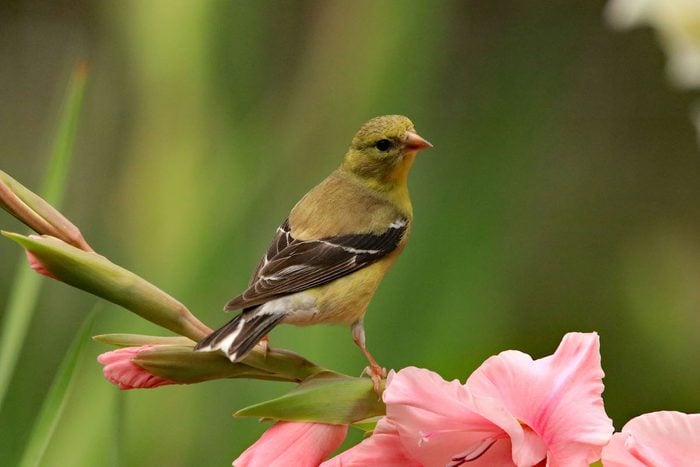
The August birth flower is the gladiolus. The tall flowering plants bring bright pops of color in a wide array of colors like purple, pink, white, yellow, and even green to the garden. You can harvest fresh-cut flowers to create your own colorful bouquets all summer long. These easy to grow plants do best in full sun and look best when planted in bunches. Don’t miss the best hummingbird gifts for any occasion.
What Are the Meanings of August’s Birth Flower?

The gladiolus stands for integrity, honor, and strength. The meaning of the gladiolus can be traced all the way back to ancient Rome when gladiators would be covered in gladiolus flowers after winning battles. The flower is also a symbol for healing. Check out the best gifts for bee lovers.
More August Birth Flowers

August has a second birth flower—the poppy. While the red poppy may be the most recognizable, poppies actually come in shades of yellow, orange and even blue too! Poppies symbolize respect and remembrance. Different color poppies also signify different meanings: red poppies mean pleasure; white poppies are given for consolation; and yellow poppies symbolize well wishes and success for the future.
Now that you know more about the August birth flower, we’ve got the perfect gifts for everyone on your August birthday list—from handmade coffee mugs and virtual painting classes to beautiful pieces of jewelry and everything in between.
August Birth Flower Poppy Gift Guide
Gladiolus Bulbs

Add bright pops of color to the birthday garden with this Mardi Gras mixture of gladiolus bulbs. These large funnel-shaped blooms will catch your eye with their vibrant shades of purple, pink and peach. Each set includes 10 bulbs. Tip: Plant bulbs every few weeks for continuous flowering throughout the season.
Personalized Poppy Note Cards Set

This personalized birth flower stationery set includes 12 folded note cards with matching envelopes. The note cards include four different designs—each with a gorgeous array of vibrant red poppies on the front, along with the name of your choice. This is a thoughtful August birth flower gift!
Gladiolus Mug

These handmade birth flower mugs are imprinted with a stamp made from a custom gladiolus drawing, then painted in a beautifully colored gaze. The name of the month and flower, along with the flower’s meaning, is inscribed on the bottom of each mug.
Poppy Flower Grow Kit

Easily grow poppy flowers with this all-in-one birthday flower kit that’s sure to make any August birthday giftee smile. The kit includes seeds, a clear vase for planting, soil-less growing material, instructions and information about what the August birth flower symbolizes. Fun!
Gladiolus Necklace

Enjoy Great Gatsby Art Deco vibes with this gladiolus necklace. The diamond-shaped hard enamel pendant is dipped in your choice of 18 karat gold or sterling silver and features three words describing the symbolism of the gladiolus on the back: integrity, persistence and strength.
Virtual Flower Painting Class

Give the gift of flowers that don’t fade. Learn to paint a personalized watercolor featuring your birth month flower in this 90-minute online class. An expert instructor guides you step-by-step through the process of creating your own piece of floral art. Supplies are not included as part of this package. Use what you already have or purchase the materials from the recommended supply list.
Poppy Enamel Keychain

Proudly carry the August birth flower all year long with this poppy-shaped enamel keychain. There’s also an option to add an engraved brass tag and gift wrapping for that extra special touch.
Poppy Birth Flower Bracelet

This dainty birth flower bracelet showcases a beautiful hand-stamped image of a poppy on a charm that hangs from a silver or gold chain. This gift is beautifully presented in custom packaging that includes the name of the birth month, birth flower and symbolism.
Poppy Cell Phone Case

Dress up your cell phone with this cheerful case covered in a colorful red and white poppy flower print. Available in a wide variety of sizes to fit your personal device, this snap case is also available in your choice of soft silicone or hard plastic. Here are unique gifts for butterfly lovers.
Personalized Poppy Art Print

Celebrate August birthdays with this personalized art print. The centerpiece is three vibrant red poppies, hand-illustrated by the artist. The name of the month, symbolism of the flower and the name of your choice are also included. Choose a digital format to print yourself or have a copy shipped to you.

As we welcome the balmy weather and long days of July, summer is in full swing. And in the garden, larkspur, also known as delphinium. the birth month flower for July, are in full bloom. Here’s everything you need to know about the July birth flower and the best July floral-inspired gifts to help your friends, family and love ones celebrate their big day.
Not celebrating a July birthday? Don’t worry—we’ve got you covered with birth flower gift guides for January, February, March, April, May, June, August, September, October, November and December too.
What is July’s Birth Flower?

July’s birth flower is the larkspur, a classic choice for a cottage garden. These annuals produce tall spired stalks covered in beautiful blooms of colorful flowers—including indigo, purple and pink—surrounded by green foliage. The name larkspur dates back to the Tudors, who likened the flower’s resemblance to a lark’s spur or claw.
Larkspurs are easy to care for and grow quickly from seed. Plant larkspur in full sun for the best blooms and avoid windy locations—the tall stalks are prone to bend over. Larkspurs are also one top tube-shaped flowers that attract hummingbirds to your garden. Cut back these pollinator-friendly flowers around midsummer for a second bloom. Be advised that all parts of all larkspur species are poisonous, so be cautious about planting around children or pets.
What Are the Meanings of July’s Birth Flower?
For those with a July birthday, the larkspur symbolizes love, positivity and an open heart. A different meaning is associated with the many colors of the vibrant bloom: pink means fickleness; white means happiness; purple represents a first love; and blue signifies grace.
More July Birth Flowers
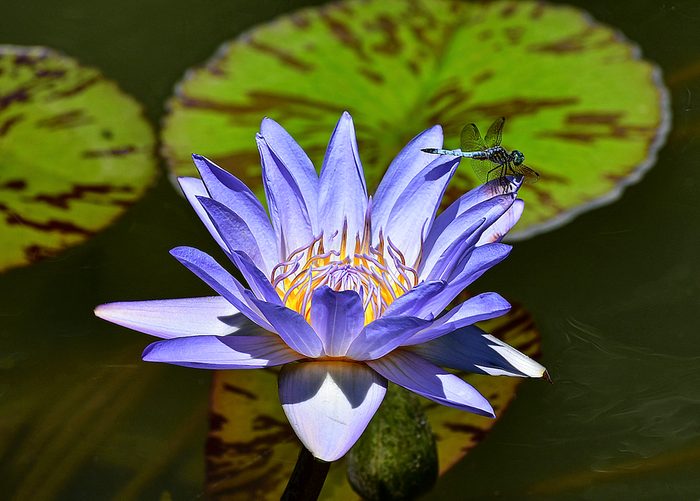
In addition to the larkspur, the water lily is also known as the July birth flower. The lotus-like flowers grow in the water and bloom from May to early September. Each flower only lasts about four days after they bloom, before settling into the water. Because of this, the water lily is commonly thought to symbolize purity and rebirth. Check out more beautiful flowers to inspire your dream garden.
Now that you know more about July’s birth flowers, we’ve got the perfect gifts for everyone on your July birthday list—from relaxing aromatherapy shower steamers and botanical scarves to tea towels and everything in between. We love a floral-inspired birthday gift!
July Birth Flower Gift Guide
Larkspur Giant Imperial Flowers

Gift larkspur flower seeds to someone celebrating a July birthday. These colorful blooms are easy to grow and don’t require much care to keep them looking beautiful in the garden. Stick the seeds inside a bird card for a fun surprise!
Larkspur Pressed Flower Necklace

July birthday babies can wear their birth flower with pride thanks to this beautiful piece of jewelry. The larkspur necklace has a real, pressed purple flower set in clear resin with gold-metallic edging. Choose from chain lengths between 16 and 34 inches.
Water Lily Shower Steamer

Treat the birthday celebrant to some at-home relaxation with these fragrant water lily shower steamers. This handmade set includes four fizzy cubes made with an essential-oil blend inspired by the water lily. It even comes in a super-cute gift box!
Larkspur Giclee Print

This gorgeous giclee print of an original painting features a bold blue stalk of larkspur visited by a monarch butterfly. This piece of art is available in four sizes and printed on high quality Arches watercolor paper for an extra-special touch.
Birth Month Flower Scarf

This botanical printed scarf features a beautiful pattern of blue larkspur flowers. This scarf is packaged in a thoughtful gift box that notes the larkspur is the July birth flower, along with the associated characteristics. It’s also available for the other 11 birth month flowers if you want to get all your gifting done at once!
Larkspur Tea Towel

This tea towel is thoughtful, functional and eye-catching. The tea towel is printed with a vibrant illustration of larkspur flowers, along with its scientific name, and what the flower symbolizes for those with July birthdays—dignity and an open heart.
Water Lily Stained Glass

This beautiful water lily stained glass piece is made by hand with an original lotus flower design. The iridescent glass looks wonderful in any window of the house. Purchase as-is or place a custom order to request a specific color scheme.
Personalized Birth Flower Mug

This personalized birth flower mug features the name of your choice, alongside an illustration of water lilies and the symbolism of the July birth flower. This mug is a nice reminder of the importance of “positivity” all year long. Other birthday flowers are also available.
Larkspur Journal

This meaningful journal proudly displays a larkspur in a full bloom laser engraved on its cover. Available in sophisticated black or brown, gift givers also have the option of customizing the vegan leather journal by adding the recipient’s name. It’s perfect for jotting down daily meditations, your birding life list, garden ideas or your friends’ and family members’ birthdays.
Birthday Flower in a Bottle

Enjoy a tiny reminder of birthday joy with this birthday flower in a bottle. The mini art piece includes real blooms inspired by July’s birth flower, birthday sparkles and a small card wishing “positivity and strength” for the year ahead.

Water features—such as bird baths, garden ponds and water fountains—are centerpieces of bird activity in yards, acting as safe places to get clean and sip fresh water. Add one to your space to attract these birds that usually turn up their beaks at birdseed offerings, but can’t resist taking a dip in a birdie pool. Here’s how to attract birds to a bird bath.
Birds That Use Bird Baths
Tanagers

Western, scarlet and summer tanagers are some of the most tropical-looking species that appear in the United States and Canada, but they tend to stay up in the treetops. Providing water can lure them down and expand the variety of birds you see in your yard, according to Laura and Mel Tracy, owners of a Wild Birds Unlimited store in Palos Park, Illinois. They’ve had summer tanagers—and several species of warblers—come to their bird bath.
Thrushes

American robins are the most familiar of these hefty, long-legged songbirds. Varied thrushes are common in the dense wet woods of the Pacific Northwest. Veery and wood thrushes boast rich cinnamon hues, while hermit and Swainson’s thrushes are more olive in tone. Depending on the area, several thrushes can show up in any yard during migration. As insect and berry specialists, thrushes aren’t particularly drawn to feeders, but they will slurp up water from a bird bath.
Bluebirds

While bluebirds are also members of the thrush family, they’re special enough to merit their own category. They may take mealworms from a feeder, but a bird bath is far more attractive to western, eastern and mountain bluebirds—especially during cold snaps. Bluebirds, robins and many other birds aren’t able to eat snow as cold-weather species (such as juncos) can, the Tracys point out. Set up a heated bird bath to keep water available year-round, even on days with freezing temperatures, to help these birds stay hydrated.
Kinglets

Tiny, active ruby-crowned and golden-crowned kinglets get their abundance of energy from scarfing insects high in the trees. Moving water may bring them down from the canopy, but they won’t sit still long. After a brief refresh session at the water, kinglets will vanish just as quickly as they appeared.
Vireos
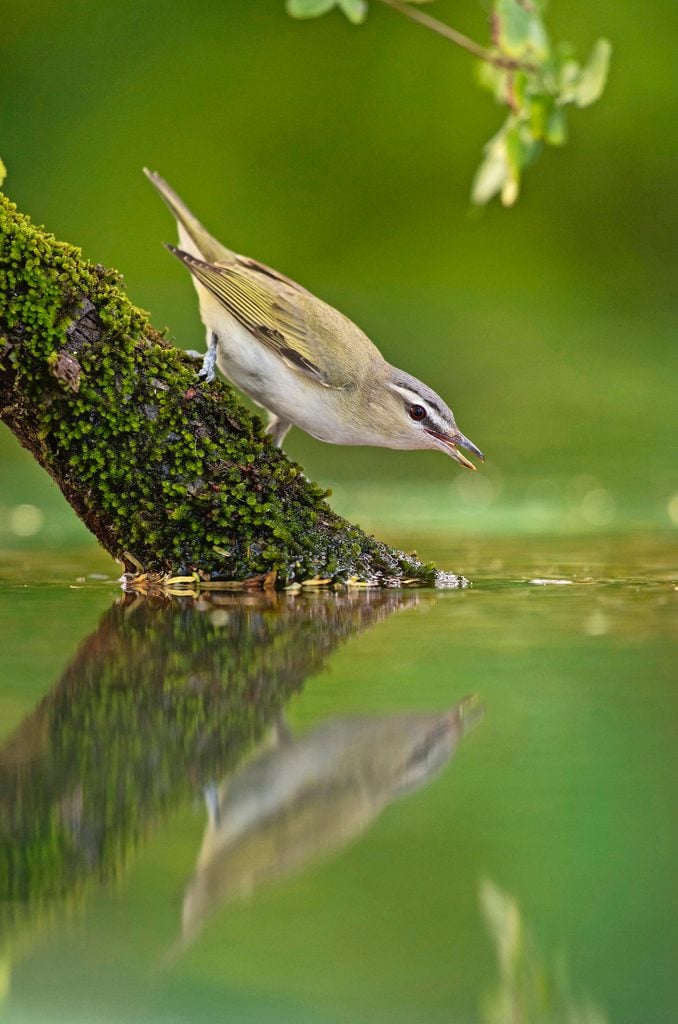
The birds in this musical group are noted for their near-constant singing from the treetops. A thicker bill helps distinguish vireos from other insect eaters. A simple water dish might not be enough to attract vireos, so consider a flowing fountain instead. Moving water cuts down on mosquito egg-laying and may even attract hummingbirds.
Thrashers

Providing shelter is another key element for successfully attracting water lovers, especially for thicket-dwelling fliers such as thrashers. Entice them by situating a bird bath near cover. Easy access to trees and shrubs protects all songbirds from predators. Wet birds cannot fly well, so they need a place to preen themselves and stay safe, the Tracys explain.
Waxwings

Both cedar and Bohemian waxwings are noted berry lovers. They travel in flocks, so sheltered perching locations and fruit-producing trees and shrubs attract these elegant visitors. After they gorge themselves on juniper, mountain ash, hawthorn or holly berries, entice them closer to the ground with a water feature.
Wrens

House, Pacific and winter wrens hop and crawl through thickets as they forage. Look for the perky behavior and striped eyebrow of Carolina wrens in the East and Bewick’s wrens in the West. The Tracys say that it’s best to place bird baths where you can see them to maximize your enjoyment of watching the birds, and also as a reminder to maintain your bird bath regularly.
Where to Place a Bird Bath
Pedestal bird baths allow you to watch birds splish-splashing around right from your window. Consider a ground-level bath, too. It mimics natural water sources and lures birds that like to stay low.
Nestle bird baths in a shady spot (to keep water fresh) that is near trees or shrubs, but not so near that predators can lurk in ambush. When a bird is taking a dip and a predator flies by, it needs a safe place to hide.
Psst—here’s how to turn a bird bath into a mini fairy garden.
Birds Prefer Shallow Water
Shallow basins are best. The water should be no deeper than 2 inches in the middle and ½ to 1 inch at the edges. Place rocks or stones in the middle of your bath for birds to perch and drink without getting their feet wet.
Will Hummingbirds Use a Bird Bath?

Hummingbirds love a light mist! To attract more hummingbirds, add motion with a dripper, fountain or mister. The noise and movement catches a bird’s attention better than standing water. Check out more information about hummingbird bird baths.
Here’s how to make a DIY hummingbird mister.
Clean Bird Baths Often
Clean and rinse your bath every couple of days and then add fresh water. Grab a wire brush for a deep clean if algae forms. You can also rinse and scrub the basin out with a solution of nine parts water to one part vinegar.
This is how to clean hummingbird feeders.
How to Make a DIY Bird Bath
Your feathered friends won’t mind if you recycle. Give a trash can lid, old frying pan or flowerpot drainage tray new life as a quick and easy DIY bird bath. Just add water!
Learn how to make a DIY concrete leaf bird bath.
Bird Bath Essential Tips
Four top tips from Wild Birds Unlimited store owners Laura and Mel Tracy.
- Change the water every few days and use a stiff brush to scrub off any debris.
- Disinfect occasionally with a mild bleach solution (1 part bleach to 10 parts water) and rinse well.
- Add the sound of moving water with a wiggler or dripper to attract migrating birds.
- Heat bird baths in the winter so visitors can clean and maintain their insulating feathers.
Next, learn how to repair a cracked bird bath.

With the arrival of spring, it is time to start thinking about getting into the garden and adding new plants. Each time I remove a plant from its container, I am looking for circling roots, which is the classic sign of a root bound plant. Find out how to fix this problem and repot a plant.
Can you reuse potting soil in planters?
How Does a Plant Become Root Bound?
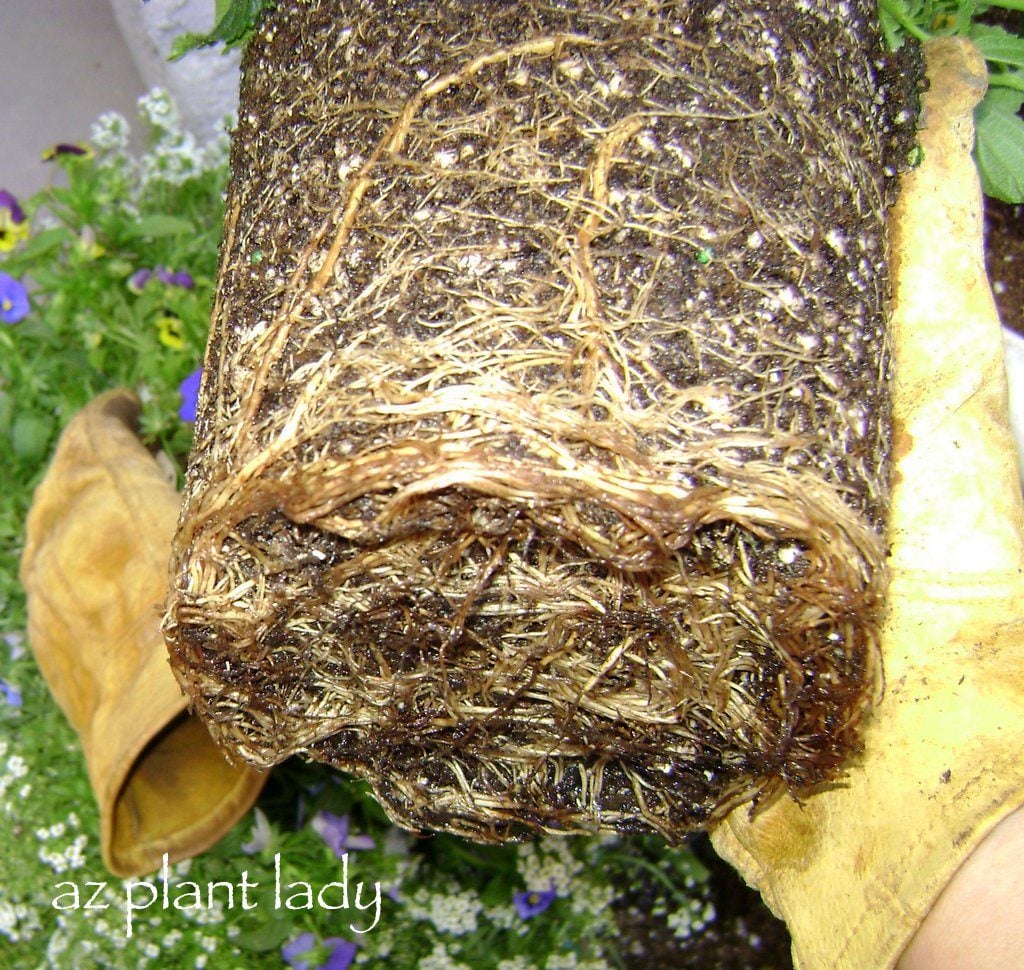
Plants become root bound (also called ‘pot bound’) when they outgrow their container and aren’t repotted in a larger one. So, their roots grow around and around, which halts growth. My new lavender plant (above) had circling roots. You can see how the roots grew in a circular pattern.
Discover easy plants you can grow in containers.
Signs of a Root Bound Plant
- Slow or no new growth.
- Roots growing out of the drainage hole.
- Plants that have been in the nursery too long without being repotted.
Check out 6 tips for watering container gardens.
How to Fix a Root Bound Plant

The solution is very simple. Cut the roots.
- Make numerous downward cuts so that the circular roots are cut. This forces the roots to grow outward when they are replanted.
- Remove any brown or black roots, which are most likely dead. Keep the white roots, which are alive.
- ‘Massage’ the root ball of your plant, which will help loosen the roots even more.
Learn how to root cuttings from plants.
Repot a Root Bound Plant

Replant your plant and its freed roots in a larger pot or in the ground. The newly cut roots will grow outward and your plant will start growing again. That’s all there is to fixing a root bound plant.
These 6 genius garden hacks will save you time and money.
I love it when gardening problems are easy to fix, don’t you?
Note: Be cautious when a garden center has a ‘special’ sale on plants. Sometimes they do this to get rid of plants that have been in their pots for too long rather than having to repot them.
Next, learn how to plant shrubs.
It’s always a delightful sight when a hummingbird zips around. If their bright colors and spunky personalities bring a smile to your face, you’ve probably wondered how to entice them to take up residence — or if a hummingbird birdhouse would convince these tiny birds to raise their babies in your yard.
Will a Hummingbird Use a Birdhouse?
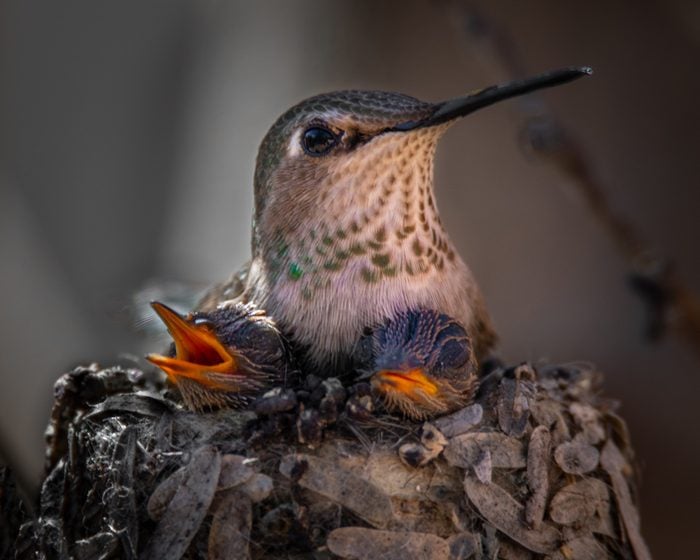
Unfortunately, the answer is no. Unlike many other common backyard birds, hummingbirds avoid using birdhouses. The size of the box, the shape, or the color doesn’t make a difference. Thus, “hummingbird birdhouse” products sold in stores or online are unlikely to work.
Why, you ask, are your hummingbirds turning their beaks up at your nice, pretty birdhouses? It’s not an intentional slight! Instead, it’s all about the type of nest they construct. John Shewey, author of The Hummingbird Handbook, explains: “Hummingbirds are biologically and evolutionarily programmed to build their cup-style nest, so the short answer as to why they don’t use birdhouses is that they are not what we call ‘cavity nesters.’”
Hummingbird nests are fascinating — here’s everything you need to know. Plus, do hummingbirds mate for life, and can hummingbirds walk?
He continues to say that “cavity nesters” like bluebirds and wood ducks cannot excavate their own holes in trees to nest, but they do build homes in cavities woodpeckers leave behind. Thus, birdhouses work for these birds because they replicate their preferred nesting environment. Hummingbirds tend to build their nests in the forks of branches and, as John says, “in fairly dense cover, well above the ground.”
Discover more jaw-dropping facts about hummingbirds, and find out how to add a hummingbird bird bath to your yard.
How to Attract Nesting Hummingbirds
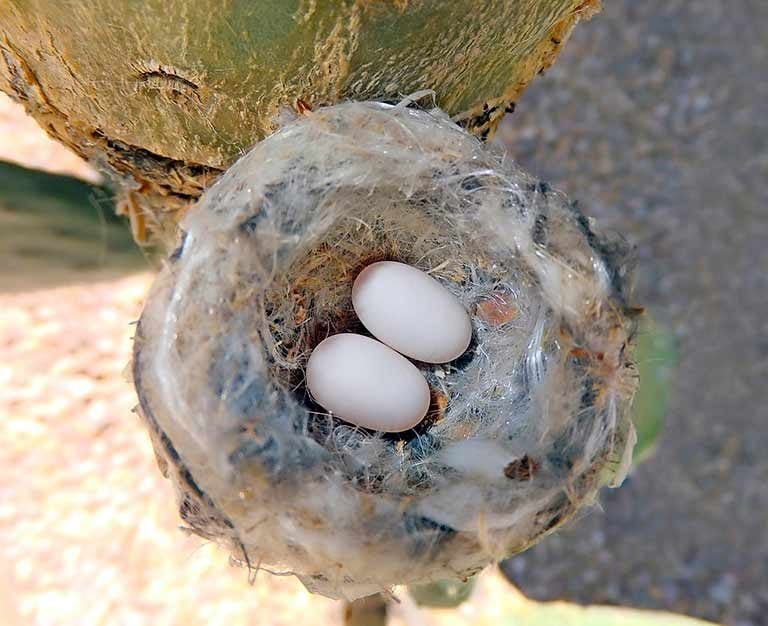
There isn’t a 100% guaranteed way to get a female hummingbird to build a nest in your yard. There are, however, a few things you can try to show your flying jewels your yard is an ideal habitat. Hummingbirds have excellent memories, so if you make your yard a bountiful food source, with feeders and flowers, they might stick around and raise young. You can try planting nectar-producing blooms, or plants that offer hummingbirds their favorite nesting materials. Here are some of the best colorful flowers to grow for hummingbirds.
Most importantly, don’t take your birdhouses down just because you can’t attract hummingbirds to use them! Bluebirds, wrens, chickadees and other backyard birds will be happy to take up residence there. Learn how to build a one-board DIY birdhouse. Plus, will robins use a bird house?
To learn more, read The Hummingbird Handbook: Everything You Need to Know About These Fascinating Birds, published by Timber Press.
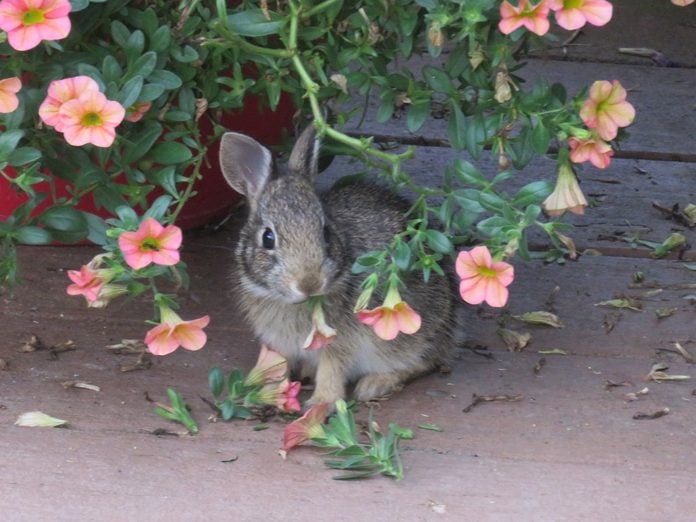
Rabbit Resistant Flowers to Grow
“Rabbits ate all of my marigolds. What are your suggestions for other colorful, long-blooming, rabbit resistant flowers?” says Peggy Connors of Newton, New Hampshire.
Seeing your precious flowers be gobbled up by wildlife can be frustrating at times! You are not alone in searching for a rabbit resistant flower garden solution.
(Psst—if squirrels are stealing all your birdseed, check out these squirrel-proof feeders.)
I hesitate to list any plant as rabbit resistant, since the eating habits of these critters can change when populations are high and their food is scarce. And know that what works in one garden may not work in another. Though marigolds are often listed as rabbit resistant flowers, you discovered that this is not always the case. The easiest solution is to try adding a variety of plants—if rabbits decide to devour one type, the other flowers can still provide needed color.
Something to keep in mind when reviewing any lists of rabbit resistant plants: There will most likely be discrepancies. Ageratum, cleome, flowering tobacco, snapdragons and verbenas appear on several rabbit resistant plant lists. Russian sage is also often listed as deer resistant and rabbit resistant. You can also try red trillium, pasque flower and wild petunia. Zinnias appear on both susceptible and rabbit resistant flowering plant lists.
Keep records of what works in your garden and be prepared to add new varieties as needed.
Fencing and Rabbit Repellents

Another solution is planting your garden just out of reach. Grow flowers and veggies in containers on a porch or deck, away from the rabbits. A 4-foot-tall wire fence, anchored tightly to the ground and securely gated, will also do. Just be sure to bury the bottom 6 inches deep to prevent rabbits from digging under it. You can also try applying homemade or commercial repellents before rabbits or other animals begin feeding, repeating as recommended to increase success. Consider products (such as Plantskydd) that are rain and snow resistant, which extends the time between applications.
Scare tactics are not always effective, especially in urban areas, as rabbits and other wildlife have grown accustomed to the sight and smell of humans. Continue to monitor your garden for damage and adjust strategies as needed.
Learn how to deter groundhogs (and keep them out of your garden).
On This Page
What Does a Purple Finch Look Like?

Purple finches are an absolute backyard treat but, despite their vivid-sounding name, their subdued pattern can make them difficult to spot. Roger Tory Peterson, the ornithologist and editor of the Peterson Field Guide series, once described a purple finch as a “sparrow dipped in raspberry juice.”
Kenn and Kimberly Kaufman, the official birding experts for Birds & Blooms, say, “Even with its beautiful raspberry tones, the adult male purple finch can be a challenge to identify. In eastern North America, the most similar bird is the male house finch. For a quick field mark, we’d look at the area of the flanks, under the wing. A house finch will always show some thick brown streaks there, whereas the purple finch is mottled with rose red.
The purple finch also has a thicker bill, rounder body and shorter tail than the house finch. These key differences can be very helpful for separating the two species at a glance.”
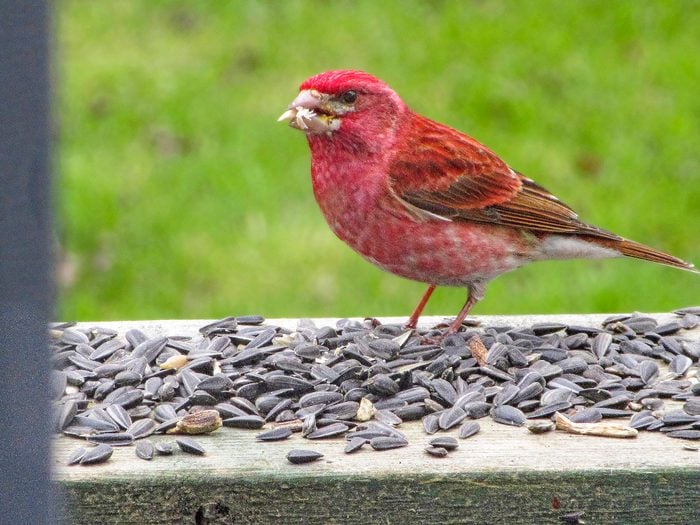
Male purple finches have an almost completely red face and neck with pinkish red also covering most of the body. Purple finches and house finches don’t flock together, but they might both show up at your feeder at the same time. Look for a bird that’s slightly larger than a chickadee or nuthatch, has a short notched tail and a prominent, strong beak, which they mainly use to crack into tough seeds.
In late summer, the purple finch begins to molt, and in winter plumage, a male’s reddish areas appear frosted. With wear, the whitish tinge disappears, revealing the rich breeding color.
In the West, Cassin’s finches also present an identification hurdle. They have a bright red cap, like the purple finch, but a lighter pink face, neck and upper chest.
Scientific Name: Haemorhous purpureus
Family: Finch
Length: 6 inches
Wingspan: 10 inches
Distinctive Markings: Male has a raspberry-red tinge, brightest on head and rump; lighter in winter. Notched tail. Female is brown-gray striped, with a dark cheek patch.
What Does a Purple Finch Eat?
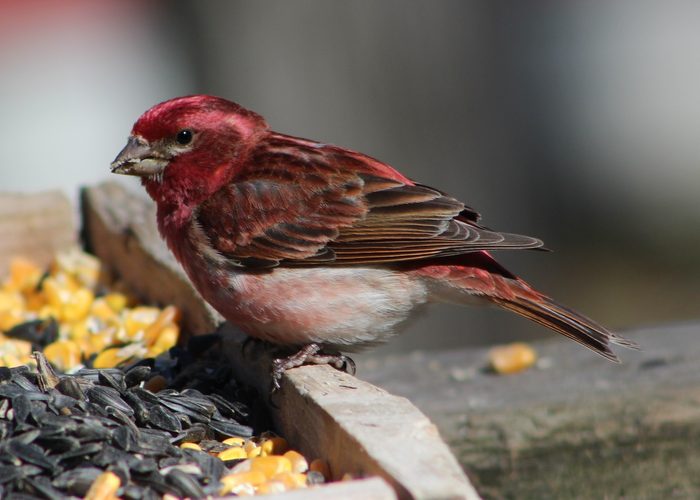
Black oil sunflower seeds seem to be the food of choice for purple finches, but they also eat white millet and thistle seeds. They also feed on buds, berries, and insects.
Purple Finch Song

Listen to the purple finch’s song. This bird sings and unstructured but melodious “fridi ferdi frididifri fridi frr” song.
Bird songs provided by the Cornell Lab of Ornithology.
A musical bird, the purple finch sometimes copies other birds, such as American goldfinches or eastern towhees, as they sing loudly from the treetops. But when it’s time to woo a mate, the male purple finch mellows his tune, hopping in front of the female and puffing his feathers. If she’s interested, the avian Romeo pops a foot in the air, vibrates his wings and then lands, presenting a twig or piece of grass.
Meet the rosy finch (and learn the best place to see one).
Purple Finch Nests and Eggs

Purple finches like to nest on the limbs of conifers, though in the southern part of their breeding range they might nest in an oak, maple or cherry tree. The female carefully builds a twig cup, about 7 inches across and 4 inches deep, lining it with grass, moss and animal fur in preparation for the young.
Clutches range from two to seven pale blue-green eggs with brown and black marks, each just under an inch long. It takes less than two weeks for the eggs to hatch. Afterward, both parents feed the naked, helpless chicks. The young grow quickly and fledge in another two weeks.
Watch your feeders in winter for a redpoll.
Purple Finch Habitat and Range Map
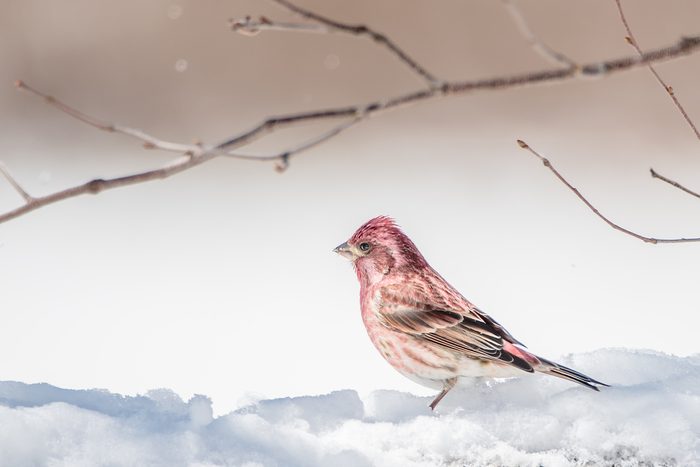
These forest-dwelling songbirds are found mainly in the Midwest, East and along the Pacific Coast. Don’t worry if these colorful finches came to your backyard last winter but don’t show up this year. They migrate erratically.
Those that breed in Canada head to the central and southern United States for the winter, while the ones that spend their summer on the Pacific Coast, around the Great Lakes and in the Northeast often don’t migrate at all, except perhaps to lower elevations.
They’ll probably be back again, especially if your feeders are filled with black oil sunflower seeds. These birds may show up in coniferous and mixed forest, oak woodlands, parks, streamsides and residential areas.
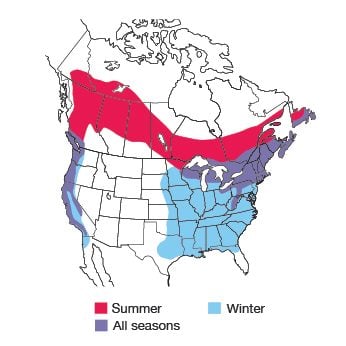
Range maps provided by Kaufman Field Guides, the official field guide of Birds & Blooms.
Next, learn how to attract goldfinches to your backyard.
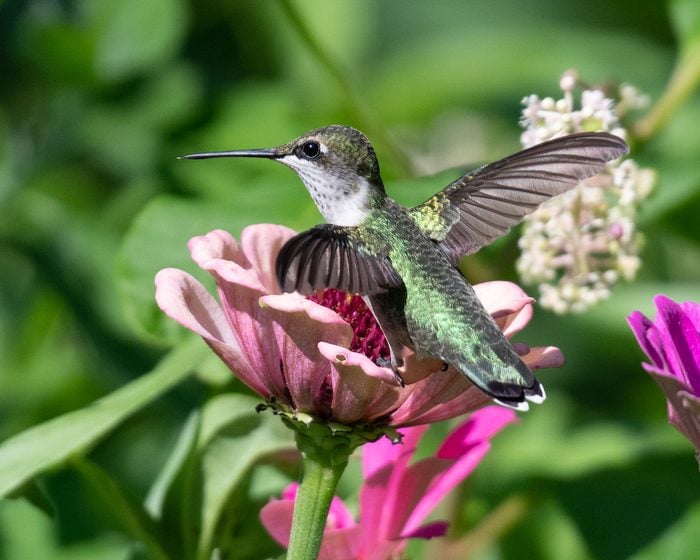
To attract birds with flowers, you’ve got to have the right plants that birds like. A lot of flowers, shrubs and trees adorn your backyard with interesting textures, bright colors and delicious scents. Use this guide to make sure you give the birds and other creatures what they need most in your yard in every season.
For a big splash of color that lasts for months, you can’t beat annual flowers. But beauty is only the beginning. Once the blooms of graceful cosmos, cheerful sunflowers, dramatic dark-leaved amaranths, bold zinnias and other easy-to-grow annuals start to fade, the real fun begins. That’s when they bring in the birds!
Even the best feeder foods often take a backseat to flower seeds. And watching a flock of goldfinches forage naturally among your plants is even more entertaining than seeing them on a tube feeder. That’s true for the dozens of bird species that avidly eat the seeds of flowers, whether it’s northern cardinals snapping up gomphrena, towhees carefully taking tithonia, or native sparrows and juncos energetically scratching beneath the marigolds. And don’t forget to mix in nectar plants for hummingbirds and berries for fruit eating birds.
Grow a goldfinch garden with their favorite plants.
Grow Plants for Birds—and Backyard Entertainment

Wildlife biologist Terry W. Johnson of Georgia marvels at the appeal. “When you see how small some of these seeds are, and how hard the cardinals work to get the tiny seeds when right nearby are black oil sunflower seeds at the feeder, it’s amazing!” he says. Annuals typically begin to attract songbirds in late summer, when the first flowers start to produce seeds.
“If zinnias are blooming on your deck or in your garden, keep your eyes peeled for petals scattered beneath the plants,” Terry urges. It’s a clue that goldfinches have been enjoying a late summer banquet, even before the seeds fully ripen. Terry sees the same telltale sign of bird activity beneath his containers of scarlet sage, a native wildflower that he has discovered is a favorite of northern cardinals.
Psst—make sure you grow plants for nesting birds
Watch Plants Closely for Seed Eaters

Seed eaters are surprisingly tricky to spot among flowers and foliage. Watch for motion—of both birds and plants. Willowy cosmos stems sway under the weight of goldfinches; marigolds and ornamental millet will bend to the ground as juncos and sparrows jump up to pull down seed heads; flashes of wings will give away cardinals, jays, chickadees and others sampling the sunflowers.
“While I was drinking my coffee and gazing out the window over the kitchen sink, I saw the globe amaranth plants in one of our deck containers violently shaking,” Terry says. “A female cardinal had landed on them and was pulling apart their flower heads! After tearing apart several blossoms to reach the tiny seeds hidden inside, the bird snipped off an entire flower head and flew away.”
Because annuals put out new blossoms, and lots of them, the bird banquet lasts for months, long after the plants are hit by a killing frost. For gardeners who may be tempted to pull out the dead plants, “simply resist the impulse to create a tidy garden,” Terry says. “Let the plants remain standing if you want to add a new facet to bird feeding. You will be providing a great source of food, and you’ll enjoy watching fascinating behavior.”
Plant these native trees that attract birds.
Attract Birds With Annuals for Every Size Garden

Even a small bed of flowers will bring in the birds. So will container gardens, which Terry and his wife especially enjoy. “As we get older, our eyesight is not as good as it used to be,” he says. “Containers bring wildlife closer to the window. We don’t even have to go outside.” A bigger annual garden will attract more birds, and more kinds of birds. Not only does it offer more seeds, but it also provides the sheltering cover that makes birds feel at home.
Plant annuals around your birdbath, feeder area, garden gnome or other outdoor ornaments, and add containers of them to your garden beds. Human-made objects create a sense of orderliness, even in winter. The flower show may be finished, but songbirds add a whole second act! Try a variety of bird-favored annuals, but grow some of them in dense patches or rows of the same kind, instead of dotting them around.
A concentrated swath of color looks great in bloom—and when seeds ripen, the patch provides the cover that songbirds seek. Be sure to plant some of your annuals a few feet from a favorite window or near an outdoor sitting area, so you can watch birds seek out the seeds as long as they last.
Grow potted flowers and plants that attract hummingbirds.
Annual Flowers That Birds Like

- Amaranth, any kind
- Brightest Brilliant Rainbow quinoa
- Calendula
- Celosia
- Cosmos
- Gomphrena (globe amaranth)
- Marigold
- Ornamental millet, such as Red Jewel or Purple Majesty
- Scarlet salvia (Salvia coccinea)
- Sunflower
- Tall verbena
- Tithonia
- Zinnia
Birds That Eat Flower Seeds

Scatter annual seeds in a sunny spot and lightly cover them for blooms in as little as six weeks, or buy started plants. The most likely diners are goldfinches, native sparrows, juncos, towhees, northern cardinals and mourning doves. Surprises such as grosbeaks, crossbills, buntings, redpolls or pine siskins may show up, too.
Plants to Attract Winter Birds

- American bittersweet (Celastrus scandens, Zones 3 to 8) Bittersweet’s showy orange berries are a favorite of more than a dozen bird species. Growing up to 30 feet tall, this vigorous grower gives ample shelter and offers its seeds to hungry birds in the cold months. You’ll need at least one male plant for every five female plants to get fruit.
- American cranberrybush viburnum (Viburnum trilobum, Zones 2 to 7) A boon to gardeners and wildlife alike, this shrub grows 8 to 10 feet tall and wide. Abundant tart red berries appear in summer and stay until late winter, providing both shots of backyard color and food for birds. Plants do best in sun to partial shade and moist, well-draining soil.
- Arborvitae (Thuja occidentalis, Zones 3 to 7) This tree is dense, with a pyramidal shape and clusters of small seed-bearing cones. It has a classic conifer look, offering generous cover for birds. Another plus: You have plenty of cultivars to choose from.
- Beautyberry (Callicarpa species, Zones 5 to 8) Beautyberry is a real showstopper in autumn. Its fall fruit lasts well into winter, or until the birds devour the last bunches of bright-purple berries. Beautyberry is a fast-growing shrub that will reach about 4 feet in height.
- Black chokeberry (Aronia melanocarpa, Zones 3 to 9) A lovely and low-maintenance shrub year-round, this chokeberry develops bluish-black fruit that attracts songbirds in fall and winter. Plants grow to be 3 to 6 feet tall and up to 10 feet wide; they do best in sun or part shade and moist, well-draining soil.
- Blue spruce (Picea pungens, Zones 2 to 8) Birds love the thick branches and prickly needles that provide winter shelter. The cones produce seed for food. This tree will do best in full sun and will grow up to 60 feet tall.
- Boxwood (Buxus species, Zones 4 to 9) Often used for hedges and topiaries, this dense evergreen shrub is covered in masses of green or variegated foliage and thrives in partial shade. Its density makes it a favorite of birds for winter cover. Many slow-growing cultivars reach just 5 feet or less.
- Firethorn (Pyracantha coccinea, Zones 5 to 9) Looking for beauty in your backyard beyond fall? Firethorn has glossy green foliage for most of the year, but it’s the compact bunches of pea-size berries that get all the attention.
- Hawthorn (Crataegus, Zones 3 to 9) Commonly used as a border tree in backyard landscapes, hawthorn is a haven for birds looking for nesting and perching sites. The tree thrives in full sun and grows to be 20 to 45 feet tall.
- Hemlock (Tsuga, Zones 4 to 8) Hemlock trees are shade-tolerant, especially when they’re young, and are popular for hedges. One variety in particular, Cole’s Prostrate, has a weeping look with a low, spreading habit and cascading branches. It provides dense shelter for ground-feeding birds like towhees and juncos.
- Holly (Ilex species, Zones 5 to 9) This winter classic is practically a necessity for bird lovers. Its beautiful green foliage supplies winter protection for flying visitors, and its bright berries are nourishing. Different holly species range from small bushes to 60-foot trees.
- Red chokeberry (Aronia arbutifolia, Zones 4 to 9) Growing 6 to 10 feet high, this resilient shrub does well even in poor soil, tolerating wet and dry conditions. It has small white or reddish blooms in spring, glossy foliage in summer and bright-red berries in fall and early winter.
- Serviceberry (Amelanchier species, Zones 3 to 9) These small trees or shrubs provide four seasons of interest in just about any landscape. The berries draw northern mockingbirds, brown thrashers, northern flickers, downy woodpeckers and more later in the year.
- Sumac (Rhus species, Zones 3 to 10) Sumac is a durable shrub or small tree that’s attractive year-round. In winter, it boasts spikes of red fruit that are an excellent source of nutrition for winter residents.
- Winterberry (Ilex verticillata, Zones 3 to 9) Few deciduous shrubs are as showy in winter as winterberry. It drops its leaves in fall, so nothing detracts from the brilliance of the red berries. Many gardeners find winterberry a must for cold-weather landscaping, and it’s easy to see why. You’ll love the colorful fruit, and the birds will love you for growing it.
Plants to Attract Spring Birds
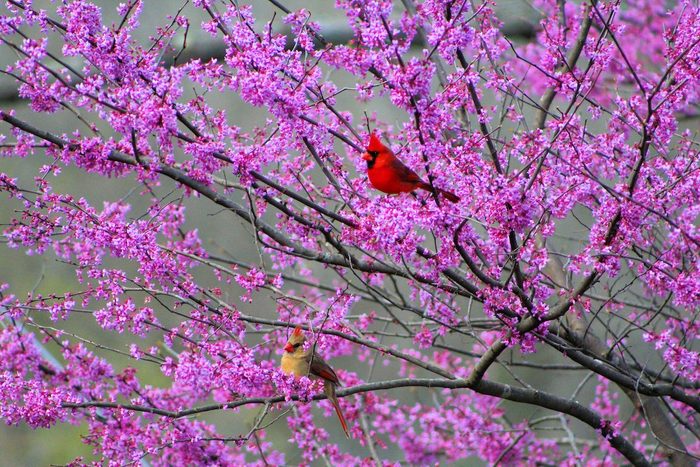
- Bachelor’s buttons (Centaurea cyanus, annual) Also known as cornflowers, bachelor’s buttons bloom in late spring through summer. The wide purple and bluish flowers look like buttons. For spring blooms, be sure to sow seeds in early fall. Likely visitors are finches, buntings and sparrows.
- Baptisia (Baptisia, Zones 3 to 9) These pretty flowers look like pea blossoms and are usually blue. A single plant can grow to be 5 feet high and 2 feet wide. Baptisia sprouts interesting seedpods that will bring in the birds.
- Buckeye (Aesculus species, Zones 3 to 8) If you’re looking to add some charm to your landscape, plant a buckeye shrub or small tree. The leaves of red buckeye are distinctive, and the showy red flowers will attract hummingbirds while providing shelter for other birds in spring.
- Butterfly weed (Asclepias tuberosa, Zones 3 to 9) Not solely for butterflies, this plant is truly multipurpose. Hummingbirds, too, love its nectar, and goldfinches and orioles are among the birds that use the silky seed down as nesting material.
- Camellia (Camellia, Zones 6 to 11) This popular evergreen flowers in the fall, winter or early spring, depending on the variety. Ideal for landscaping, it has lovely rose-shaped blooms, usually in red, pink or white. Birds will appreciate the shrub during nesting season. Expect camellia to be anywhere from 3 to 20 feet high.
- Cherry (Prunus species, Zones 3 to 9) Beautiful pink blooms open in spring, and small red or black fruit appears in summer. The birds will welcome the shelter and eat up the berries in summer. Cherry trees come in dwarf varieties if you don’t want a large one.
- Columbine (Aquilegia, Zones 3 to 9) The blooms of columbine are truly stunning. Hummingbirds and butterflies love them, too! Remove spent blossoms to encourage more to form into early summer. Avoid fertilizing too much, which results in fewer blooms.
- Foxglove (Digitalis, Zones 3 to 10) Foxglove is a short-lived perennial or a biennial. Its tubular, bell-shaped blooms come in a variety of colors: apricot, pink, golden brown, coppery rose and more. Hummingbirds love the flowers.
- Fuchsia (Fuchsia species, annual to Zone 8) Fuchsia’s showy red, white, pink and purple blooms will capture your heart and bring in the hummingbirds. There are more than 100 kinds, from low-growing dwarfs to upright varieties. Most plants are 6 to 24 inches. Fuchsia grows best in partial shade.
- Lupine (Lupinus perennis, Zones 3 to 9) Lupine blooms from late spring to early summer. It grows to about 3 to 4 feet tall and produces spires of blooms that look like pea blossoms. Lupine will do best in full sun to partial shade.
- Phlox (Phlox, Zones 3 to 9) These old-fashioned beauties attract hummingbirds and butterflies as soon as they start blooming in spring. The flowers, prized for their scent, come in many colors, sizes and bloom times. Most varieties prefer full sun.
- Pine (Pinus, most zones, check species) Pines provide the shelter and nesting space that spring birds need. Plant trees any time from spring to fall in moist, well-draining soil. But beware: Some pine trees can grow to be 75 feet tall.
- Redbud (Cercis species, Zones 4 to 10) Redbud’s blooms attract hummingbirds and butterflies, as well as pollinating insects that benefit your backyard. The seeds appeal to chickadees, goldfinches and others, and nuthatches and woodpeckers love the insects in the bark.
- Red-hot poker (Kniphofia, Zones 5 to 9) It’s easy to see why this plant is also called a torch lily. Birds love this stately flower, which changes in color from yellow at the base to bright red at the tip. Depending on the cultivar, it will bloom in late spring to autumn, and attract flocks of hummingbirds along the way.
- Rhododendron (Rhododendron species, Zones 4 to 9) Plant rhododendron in a lightly shaded area with protection from winter sun and winds. Moist, acidic soil that drains well will help it thrive. Rhododendron offers ample shelter and enticing nectar.
- Viburnum (Viburnum species, Zones 3 to 10) This bush draws a variety of birds with nesting space and summer-to-winter fruit. Viburnum is among the most popular ornamental shrubs and small trees because it’s beautiful, versatile and easy to grow.
Plants That Summer Birds Like
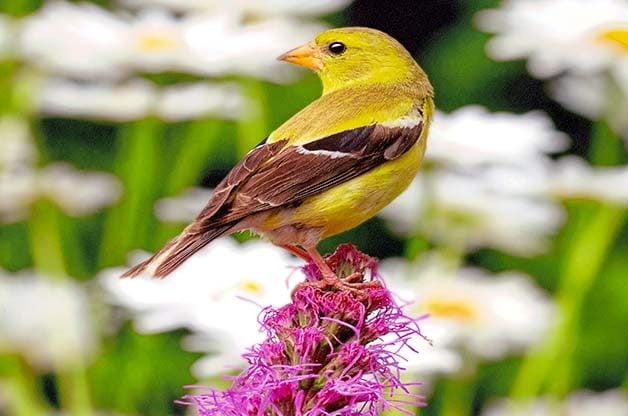
- Bee balm (Monarda, Zones 3 to 9) If you want to lure hummingbirds and butterflies, this easy-to-grow perennial is a good selection. Its bright colors and nectar-filled blooms attract a variety of pretty fliers. This beauty grows up to 4 feet tall and starts flowering in midsummer.
- Black-eyed Susan (Rudbeckia species, Zones 3 to 9) Birds adore this garden classic. The traditional black-eyed Susan has a dark center and bright-yellow petals, but now there are a few new color combos to choose from. Grow in full sun to light shade for blooms in summer through autumn. House finches, chickadees and American goldfinches will feed on the seed heads.
- Blanket flower (Gaillardia x grandiflora, Zones 3 to 9) Blanket flower will bloom all summer, showing off its red and yellow blooms with purple centers. The plant is generally 2 to 3 feet tall and does best in full sun.
- Coral bells (Heuchera, Zones 3 to 9) Rich, fertile soil is best and partial shade ideal for this handsome plant. Coral bells are valued for their colorful, often purple foliage. In late spring, the plant sends up attractive, long-lasting wands of tiny flowers that hummingbirds will love.
- Coreopsis (Coreopsis species, Zones 3 to 11) Nectar-rich blooms appeal to hummingbirds and butterflies, while the seeds provide food for sparrows, chickadees, finches and other seed-eating birds. Plant drought-tolerant coreopsis in full sun.
- Cosmos (Cosmos bipinnatus, annual) Birds can’t resist these colorful pinwheel-shaped blooms nestled in feathery foliage. Grow single or double cultivars in full sun, and you’ll have flowers and seeds from summer through fall.
- Flowering tobacco (Nicotiana alata, annual) For a no-fuss way to liven up your garden with hummingbirds and butterflies, plant flowering tobacco. The stems rise from a rosette of leaves and are covered with star-shaped flowers in shades of pink, red, maroon, lavender, white, yellow and even green.
- Liatris (Liatris spicata, Zones 3 to 9) Also called gayfeather or blazing star, this flower shines in late spring through summer. It attracts hummingbirds to its spikes of lavender, rose or white blossoms. American goldfinches, tufted titmice and other seed eaters savor its seed heads.
- Penstemon (Penstemon species, Zones 3 to 10) Hummingbirds love these red, purple, blue, pink and white flowers on plants that reach up to 4 feet, blooming profusely for most or all of the summer. Full sun and well-draining soil are ideal; damp or rich soil makes penstemon rot.
- Primrose (Primula vulgaris, Zones 4 to 8) English primrose is a favorite of hummingbirds, butterflies and bees because of its alluring fragrance in early summer. It’s generally a profuse bloomer, doing best in partial shade.
- Purple coneflower (Echinacea species, Zones 3 to 10) The large, showy blooms of coneflowers will attract birds, butterflies and bees. Plant bare-root perennials in spring, or plant container-grown specimens any time during the growing season. Cut back half your coneflowers in early summer to delay flowering and prolong overall bloom time.
- Salvia (Salvia species, Zones 4 to 9) Annual salvia is a garden favorite, but don’t forget the perennials. Loose flower spires reach heights from 1 to 5 feet. The blooms come in bright shades of red, maroon, purple and indigo—and hummingbird love them!
- Stokesia (Stokesia laevis, Zones 5 to 9) Blooming from early summer until fall, stokesia boasts 3- to 5-inch-wide blue, lavender or pink blooms with ragged-toothed petals around a creamy center. Regular deadheading will extend blooms and ensure plenty of bird activity.
- Trumpet vine (Campsis radicans, Zones 4 to 9) Trumpet vine blooms are orange-red in color and tubular in shape, making them a favorite of hummingbirds. Surprisingly, this vine can grow to be 40 feet tall. Plant it in full sun.
- Yarrow (Achillea species, Zones 3 to 10) Flattened clusters of tiny flowers attract hummingbirds and butterflies, while the seeds of yarrow appeal to many songbirds.
- Zinnia (Zinnia, annual) An old-fashioned favorite, zinnias are best loved for their long-lasting blooms, which require minimal care. The flowers will attract hummingbirds and butterflies in the heat of summer. And without deadheading, zinnias will bloom into fall.
Plants to Attract Fall Birds
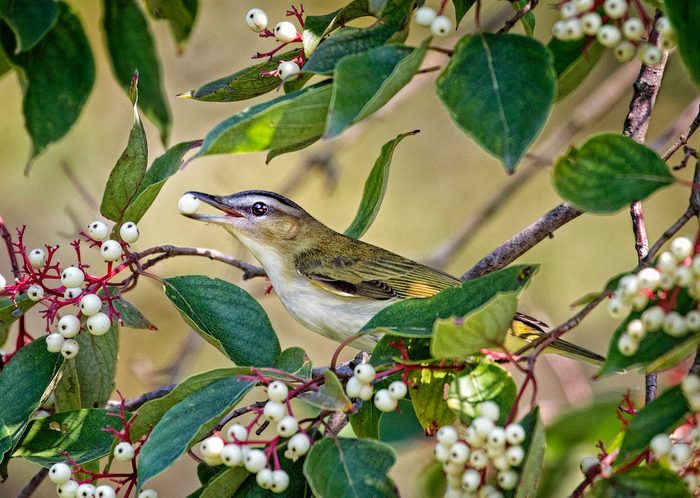
- Aster (Aster species, Zones 3 to 8) The aster brings an explosion of color to the end of the growing season, a guaranteed lure for fall butterflies. From miniature alpine plants to giants up to 6 feet tall, it will brighten up fall in your backyard. Plant early in the season in Northern states so it can get established before winter.
- Crabapple (Malus species, Zones 2 to 9) These highly decorative flowering trees produce small fruits that attract more than 20 bird species but are especially favored by cedar waxwings, robins and northern cardinals. Crabapple varieties tend to be 10 to 25 feet tall and grow best in full sun.
- Dogwood (Cornus species, Zones 2 to 8) Bursting with berries, this garden favorite feeds robins, bluebirds, cardinals and dozens of other backyard birds during the colder months. Dogwoods do best in full sun to partial shade and prefer moist soil.
- Elderberry (Sambucus species, Zones 3 to 9) A luxurious shrub with long, drooping branches, this elderberry produces flat white clusters of flowers that turn into purple berries in late summer. The fruit is relished by gray catbirds, robins, bluebirds and many other backyard songbirds.
- Fountain grass (Pennisetum alopecuroides, Zones 5 to 9) With full tufts of fuzzy flower spikes that turn into natural birdseed, fountain grass seems to be heaven-sent. One or more of its many varieties, which reach 2 to 5 feet, will add charm to your backyard wildlife habitat.
- Four-o’clocks (Mirabilis jalapa, annual) The blooms of four-o’clocks earn their name, opening in mid-afternoon and fading before sunrise. The nectar-rich flowers are a favorite evening stop for hummingbirds and butterflies.
- Goldenrod (Solidago species, Zones 3 to 9) All it takes is a few goldenrod plants to light up your garden in late summer, and provide birds a continual food source. Also, give the plants plenty of room to spread. They won’t disappoint, especially as many other plants fade.
- Grape (Vitis, Zones 2 to 9) This high-sugar fruit provides lots of energy for birds. The woody deciduous vines grow up to 30 feet long, thrive in full sun and produce late-summer and autumn fruit in a variety of sizes and flavors, some of which are unpalatable to humans.
- Joe Pye weed (Eupatorium purpureum, Zones 4 to 9) Grow Joe Pye weed in average to moist soil. It offers a great supply of seed that birds will love. Pinch back early in the season to grow shorter plants and boost flower production.
- Mahonia (Mahonia, Zones 5 to 11) This evergreen shrub has spiny-edged leaves and, in late summer and fall, bears clusters of blue-black berries. Various species grow from 1 to 12 feet in full sun to light shade.
- Marigold (Tagetes, annual) If brilliant and lasting color is what you’re looking for, look no further. Marigolds are tough garden plants that bloom through fall and attract birds. They grow to be 6 inches to 3 feet tall.
- Mountain ash (Sorbus species, Zones 2 to 7) A good choice for small landscapes, this medium-size mountain ash tree boasts spectacular yellow and red fall foliage. The orange fruit attracts flocks of cedar waxwings, robins, gray catbirds, thrashers, eastern bluebirds and at least a dozen other bird species.
- Nasturtium (Tropaeolum majus, annual) Nasturtiums will bloom from early summer straight through until frost. Extremely low-maintenance plants, they have funnel-shaped flowers and large, veined leaves. Hummingbirds and butterflies will stop to visit the blooms, and it’s also worth noting that all parts of the plant are edible for humans!
- Rugosa rose (Rosa rugosa, Zones 2 to 8) Love roses but hate the hassle? This fast-growing variety flourishes anywhere without the fuss. Rugosa roses handle poor soil conditions, from sandy to salty, and produce bright rose hips that attract countless birds.
- Sedum (Sedum species, Zones 3 to 10) Just when your other plants begin their fall decline, Autumn Fire sedum will take the spotlight with its brightening star-shaped blooms. Most sedums are hardy in all but the coldest climates. The late-autumn seed heads attract birds, including finches and chickadees, so don’t cut them back until spring.
- Sunflower (Helianthus annuus, annual) Sunflowers are dependable bird magnets. Cultivars range from 2 to 15 feet tall and are mainly yellow, although some varieties are red or brown. In early autumn, this stately beauty attracts all seed eaters.